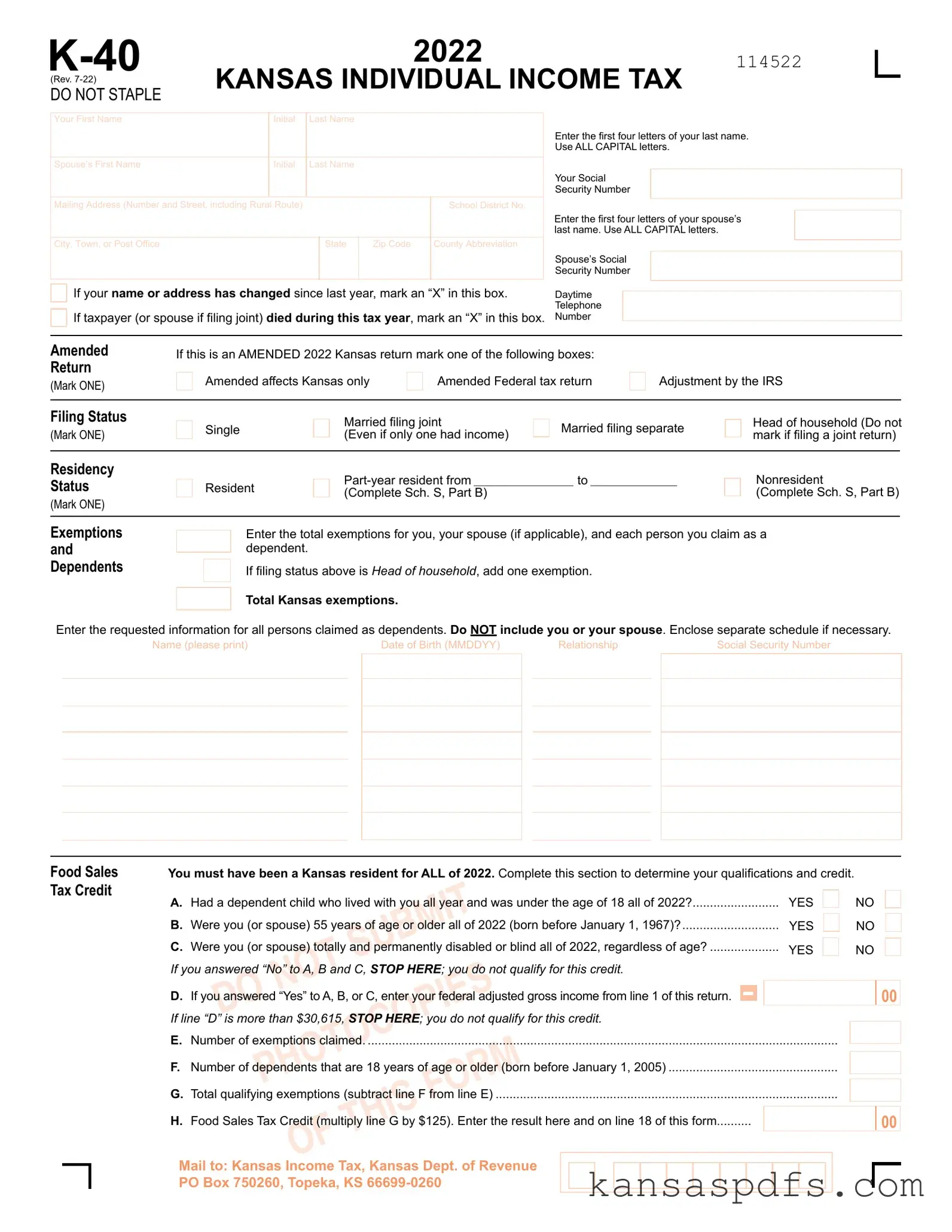|
|
|
|
|
|
|
ENTER AMOUNTS IN WHOLE DOLLARS ONLY |
|
|
|
|
|
|
114222 |
|
|
|
|
|
|
|
|
|
|
|
|
|
|
|
|
|
|
|
|
|
|
|
|
|
|
|
|
|
|
|
|
|
|
|
|
|
|
|
|
|
|
|
|
|
|
|
|
|
|
|
|
|
|
|
|
|
|
|
|
Income |
1. |
Federal adjusted gross income (as reported on your federal income tax return) |
|
1 |
|
|
|
|
|
00 |
|
Shade the box for |
2. |
.......................................Modifications (from Schedule S, line A25; enclose Schedule S) |
|
2 |
|
|
|
|
|
00 |
|
|
|
|
|
|
|
|
|
|
|
|
|
|
|
|
|
negative amounts. |
3. |
Kansas adjusted gross income (line 2 added to or subtracted from line 1) |
|
|
|
|
|
|
|
|
|
|
Example: |
|
|
|
3 |
|
|
|
|
|
00 |
|
Deductions |
4. |
Standard deduction OR itemized deductions (if itemizing, complete Kansas Schedule A) |
... |
|
4 |
|
|
00 |
|
|
|
|
|
|
5. |
Exemption allowance ($2,250 x number of exemptions claimed) |
|
|
|
5 |
|
|
00 |
|
|
|
|
|
|
6. |
Total deductions (add lines 4 and 5) |
|
|
|
6 |
|
|
00 |
|
|
|
|
|
|
7. |
.......................................Taxable income (subtract line 6 from line 3; if less than zero, enter 0) |
|
|
|
|
7 |
|
|
00 |
|
Tax |
8. |
Tax (from Tax Tables or Tax Computation Schedule) |
|
|
|
8 |
|
|
00 |
|
Computation |
9. |
Nonresident percentage (from Schedule S, line B23; or if 100%, enter 100.0000) |
|
|
|
9 |
|
|
|
|
|
|
|
|
|
|
|
|
|
|
|
|
|
|
|
|
|
10. |
Nonresident tax (multiply line 8 by line 9) |
|
|
|
10 |
|
|
00 |
|
|
|
|
|
|
11. |
Kansas tax on lump sum distributions (residents only - see instructions) |
|
|
|
11 |
|
|
00 |
|
|
|
|
|
|
12. |
TOTAL INCOME TAX (residents: add lines 8 & 11; nonresidents: enter amount from line 10).. |
|
12 |
|
|
00 |
|
Credits |
13. |
Credit for taxes paid to other states (see instructions; enclose return(s) from other states) |
|
|
|
|
13 |
|
|
00 |
|
|
|
|
|
|
14. |
Credit for child and dependent care expenses (residents only - see instructions) |
|
|
|
14 |
|
|
00 |
|
|
|
|
|
|
15. |
Other credits (enclose all appropriate credit schedules) |
|
|
|
15 |
|
|
00 |
|
|
|
|
|
|
16. |
Subtotal (subtract lines 13, 14 and 15 from line 12) |
|
|
|
16 |
|
|
00 |
|
|
|
|
|
|
17. |
Earned income tax credit (from worksheet on page 8 of instructions) |
|
|
|
17 |
|
|
00 |
|
|
|
|
|
|
18. |
Food sales tax credit (from line H, front of this form) |
|
|
|
18 |
|
|
00 |
|
|
|
|
|
|
19. |
Total tax balance (subtract lines 17 and 18 from line 16; cannot be less than zero) |
|
|
|
|
19 |
|
|
00 |
|
Withholding |
20. |
Kansas income tax withheld from W-2s and/or 1099s |
|
|
|
20 |
|
|
00 |
|
and |
21. |
Estimated tax paid |
|
|
|
|
|
|
21 |
|
|
00 |
|
Payments |
22. |
Amount paid with Kansas extension |
|
|
|
22 |
|
|
00 |
|
If this is an AMENDED |
23. |
Refundable portion of earned income tax credit (from worksheet, page 8 of instructions).... |
|
|
|
23 |
|
|
00 |
|
return, complete lines |
24. |
Refundable portion of tax credits |
|
|
|
24 |
|
|
00 |
|
25, 26 and 27 |
|
|
|
|
|
|
|
|
|
|
|
25. |
Payments remitted with original return |
|
|
|
25 |
|
|
00 |
|
|
|
|
|
|
26. |
Credit for tax paid on the K-120S (enclose K-9) |
|
|
|
26 |
|
|
00 |
|
|
|
|
|
|
27. |
Overpayment from original return (this figure is a subtraction; see instructions) |
|
|
|
|
|
27 |
|
|
00 |
|
|
|
|
|
|
|
|
|
|
|
|
|
|
|
|
|
28. |
...........................Total refundable credits (add lines 20 through 26; then subtract line 27) |
|
28 |
|
|
|
|
|
00 |
|
|
|
|
|
|
|
|
|
|
|
Balance |
29. |
Underpayment (if line 19 is greater than line 28, enter the difference here) |
|
|
|
|
29 |
|
|
00 |
|
Due |
30. |
Interest (see instructions) |
|
|
|
|
|
|
30 |
|
|
00 |
|
|
|
|
|
|
31. |
Penalty (see instructions) |
|
|
|
|
|
|
31 |
|
|
00 |
|
|
|
|
|
|
32. |
Estimated Tax Penalty |
Mark box if engaged in commercial farming or fishing in 2022 .. |
|
32 |
|
|
00 |
|
|
|
|
|
|
33. |
AMOUNT YOU OWE (add lines 29 through 32 and any entries on lines 36 through 42) |
|
|
|
33 |
|
|
00 |
|
Overpayment 34. |
Overpayment (if line 19 is less than line 28, enter the difference here) |
|
|
|
|
34 |
|
|
00 |
|
|
|
|
35 |
|
|
00 |
|
You may donate to any |
35. |
CREDIT FORWARD (enter amount you wish to be applied to your 2023 estimated tax) |
|
|
|
|
|
|
of the programs on lines |
36. |
CHICKADEE CHECKOFF (Kansas Nongame Wildlife Improvement Program) |
|
|
|
36 |
|
|
00 |
|
36 through 42. |
|
|
|
|
|
|
|
|
|
37 |
|
|
00 |
|
The amount you enter |
37. |
SENIOR CITIZENS MEALS ON WHEELS CONTRIBUTION PROGRAM |
|
|
|
|
|
|
will reduce your refund |
|
|
|
|
|
|
|
|
|
38 |
|
|
00 |
|
or increase the amount |
38. |
BREAST CANCER RESEARCH FUND |
|
|
|
|
|
|
you owe. |
|
|
|
|
|
|
|
|
|
39 |
|
|
00 |
|
|
|
|
|
|
39. |
MILITARY EMERGENCY RELIEF FUND |
|
|
|
|
|
|
|
|
|
|
|
40. |
KANSAS HOMETOWN HEROES FUND |
|
|
|
40 |
|
|
00 |
|
|
|
|
|
|
41. |
KANSAS CREATIVE ARTS INDUSTRY FUND |
|
|
|
41 |
|
|
00 |
|
|
|
|
|
|
42. |
LOCAL SCHOOL DISTRICT CONTRIBUTION FUND School District Number |
|
|
|
|
|
42 |
|
|
00 |
|
|
|
|
|
|
|
|
|
|
|
|
|
|
|
|
|
|
|
|
43. |
REFUND (subtract lines 35 through 42 from line 34) |
|
|
|
43 |
|
|
00 |
|
|
|
|
|
|
|
|
|
|
|
|
|
|
|
|
|
|
|
|
|
|


